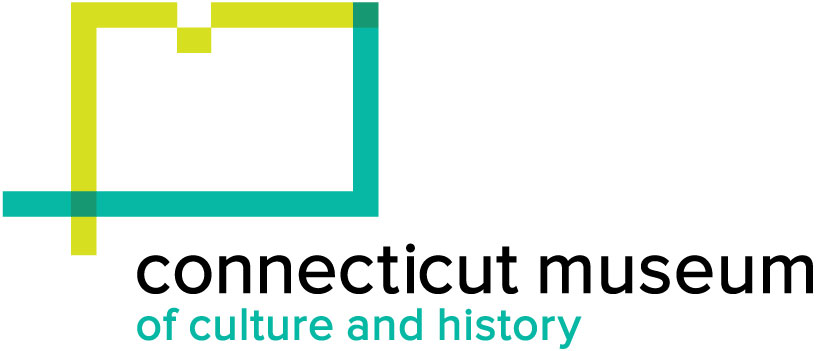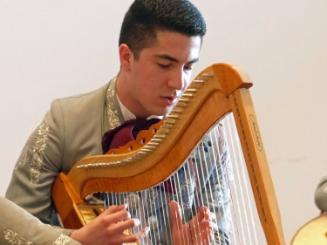Ambassadors of Folk Exhibit Gallery
Date2010-2011
Mediumborn digital video
DimensionsDuration: 14 Seconds
ClassificationsGraphics
Credit LineConnecticut Cultural Heritage Arts Program collections
CopyrightIn Copyright
Object number2015.196.274.6
DescriptionVideo showing the gallery for the exhibition, "Ambassadors of Folk: Connecticut Master Traditional Artists." The works shown were made by Fatima Vejzovic and Eldrid Arntzen.
NotesSubject Note: "Ambassadors of Folk: Connecticut Master Traditional Artists" was an exhibit presented at the Institute for Community Research in Hartford, Connecticut, from June 10 through October 2010. Curated by the Connecticut Cultural Heritage Arts Program, the exhibit showcased the artistry of Connecticut folk and traditional artists who have achieved recognition on a national or international scale. The exhibit brought to wider attention the mastery of local artists who are highly respected exemplars of ethnic traditions within their communities. The eight visual artists and two performers featured represent a wide variety of artistic genres and ethnicities and share a high degree of technical skill and sophistication. The artists’ accomplishments represent entire lives spent serving their communities through cultural production. This exhibit celebrated the twenty years that the Connecticut Cultural Heritage Arts Program has worked with these and other remarkable traditional artists and their communities across the state.Artists included Aldona Saimininkas, East Hartford; Romulo Chanduvi, East Hartford; Jampa Tsondue, Old Saybrook; Eldrid Arntzen, Watertown; Paul Luniw, Terryville; Valentine and Aili Galasyn, Canterbury; Shengzhu Chen Bernardin, Torrington; Marek Czarnecki, Meriden; Fatima Vejzovic, Hartford; performers Negrura Peruana, East Hartford and Daniel Boucher, Bristol. Art forms exhibited drew from roots in Lithuania, Peru, Tibet, Norway, Ukraine, Finland, China, and Eastern Europe, but were all made and used here in Connecticut and beyond. One unifying characteristic is that these pieces have been created for use in a community’s traditional practices. For example, the Buddhist thangka paintings and the Byzantine Christian icons encourage active veneration, they serve a purpose beyond being paintings to be viewed. Other forms on display include decorative containers, cloth, commemorative pictures and rugs, wood carvings, and important seasonal decorations such as two types of dyed and etched Easter eggs. Performance traditions originate from African Peru and Québec. All of the art forms are beloved in the artists’ communities in Connecticut, where they serve as important expressions of cultural identity and heritage.
Biographical Note: Eldrid Arntzen was born in the Bay Ridge section of Brooklyn in 1935, which had a Norwegian immigrant population of around 50,000. She has been painting various styles of rosemaling, decorative painting on wood, since the age of ten, studying with rosemaling masters in Norway and the United States. Her work has received recognition from members of the Norwegian-American community by being chosen as the Gold Medal winner in 1987 and the People’s Choice Award in 2003 at Vesterheim, the Norwegian-American museum in Decorah, Iowa. In April 2004, Eldrid was an invited panelist and teacher for the first international symposium on rosemaling, organized by Vesterheim. This significant honor situates her among the leaders of this folk art form such as Nils Ellingsgard and Sigmund Aarseth from Norway.
Eldrid has traveled all over the country to demonstrate and teach rosemaling. In addition to her classes at Vesterheim's Handverkskole, she was a regular summer teacher at Fletcher Farm School in Vermont and Land of the Vikings in Pennsylvania. She has taught American rosemaling in Norway and conducted workshops for the Sons of Norway in Fairbanks, Alaska. As a master traditional artist in the Institute for Community Research's Southern New England Traditional Arts Apprenticeship Program, Eldrid taught rosemaling design to three apprentices from Massachusetts and one from Connecticut. Eldrid’s house is full of boxes, chairs, bowls, cabinets, trays, and containers that she has painted for her family to use.
Rosemaling on wood furniture, household objects, and even walls flourished in rural Norway during the mid-17th to the mid-19th centuries and was transplanted to America by immigrants. There are numerous styles within rosemaling, requiring different designs, colors, and brush techniques. As well as the Valdres style, Eldrid paints styles including Hallingdal, Gudbrandsdal, Vest Agder, Aust Agder, and her favorite, the asymmetrical Telemark style which itself has several variants. A hallmark of Eldrid's skill is that she is one of only a few in the United States who are excellent painters of rosemaling styles from so many districts.
In 1996, her paintings were selected for an exhibition "Norwegian Folk Art: Migration of a Tradition" that traveled throughout the U.S. and Norway. She was one of three American painters to participate in the 2004 international symposium, The Art of Rosemaling: Tradition Meets the Creative Mind. In 2005, Eldrid was honored by the National Endowment for the Arts (NEA) with its National Heritage Fellowship Award, the nation's highest honor in traditional arts. NEA bestows this award to only twelve artists nationwide each year, chosen for their artistic excellence, cultural authenticity, and contributions to their communities.
Biographical Note: Fatima Vejzovic is a skilled weaver of traditional Bosnian wool flat-weave carpets made on a simple wooden loom constructed by family members in her home. She learned this traditional craft from mothers, aunts, neighbors, and friends in her village, using wool from sheep raised on their farm. After the war Fatima and many weavers worked for Bosfam, a successful crafts cooperative established in Tuzla to assist women with income-generating projects while providing therapeutic and social support. Their work has appeared in catalogues selling the carpets internationally. Fatima arrived in Hartford with her family in 2002. Greater Hartford is now home to over 10,000 Bosnians, most coming as refugees from the war in the former Yugoslavia. For the women in the community, many of them widows, continuing to practice their familiar arts of weaving, knitting, and crochet lace helps them to cope with the trauma of the genocide their families suffered. Fatima’s art works include large floor carpets as well as smaller weavings, and she fashions the woven tapestry fabric into bags, purses, and pillows. Fatima also makes hand-knitted clothes, crochet lace tablecloths, and Bosnian socks worn inside the home. She won a 2021 Connecticut Office of the Arts Fellowship in Folk and Traditional Arts.
Bosnian flat-weave carpets, called ćilimi after their Turkish antecedents (kilims), adorn all parts of the home – floors, walls, chairs and sofas, tables, and beds. The weavings also serve an important function as prayer rugs for these Muslim families. While sometimes made commercially with chemical dyes, the traditional rugs woven by village women still use wool processed by them and colored with natural dyes. Ćilimi designs maintain their Turkish roots but also show European influences stemming from Bosnia’s close connections with Vienna in the early 20th century. Fatima weaves traditional geometric patterns in seemingly endless variations, and she also enjoys adding floral motifs and creating new pictorial designs. Fatima does not use templates or printed patterns – her designs are created as she starts a weaving on the loom, depending on what colors of wool she has available. She developed a new idea for a weaving depicting a whimsical goat, that she made into bags and wall hangings that have become very popular. Fatima also weaves lettering and names into a ćilim, creating a narrative feature that led to a multi-year commission to produce commemorative banners in the organization’s colors for the Aurora Foundation’s retiring board members.
Through a partnership with Clatter Ridge Farm, whose sheep graze on the grounds of the Hill-Stead Museum in Farmington, Connecticut, Fatima has created a series of weavings using their high-quality Shetland wool. The undyed wool gives the rugs a beautiful softness and durability as well as subtle variations of natural color.
Fatima taught her daughter, Fikreta Muratovic, to weave and they worked together for the Bosfam enterprise in Bosnia. As part of the Southern New England Traditional Arts Apprenticeship Program in 2005, Fatima taught loom weaving to a younger Bosnian woman in Hartford, helping to pass on this beloved tradition in their new home. Fatima has given weaving workshops to Hartford students at four schools through Hartford Performs, and to students from Miss Porters School and the Greater Hartford Academy of the Arts. Fatima has worked with three interns from Trinity College through the Sewing Circle Project. As part of the Hartford Performs program for teaching artists in schools, Fatima has taught the basics of loom weaving to students in Hartford, Windsor Locks, and Miss Porter’s School.
Fatima was one of the founding members of the Sewing Circle Project, which began in early 2007 as a partnership to encourage cultural sustainability among the many immigrant and refugee communities in the Greater Hartford area and across Connecticut. Engaging with public audiences has given Fatima opportunities to improve her English-speaking skills, broaden her social networks, and showcase Bosnian cultural traditions. She has demonstrated and sold her work at the Hartford Public Library World Refugee Day; Hartford Open Studio Weekends; the University of Connecticut; the Hill-Stead Museum; the Vermont Folklife Center; the American Folklore Society; the New York Folklore Society; the West Hartford Art League; Ten Thousand Villages; several local house parties; and at the Billings Forge Farmers Market. She enjoys creating new designs for private commissions. Fatima’s work has been included in exhibitions at the Institute for Community Research, the Connecticut Historical Society, the Connecticut Office of the Arts Gallery, and the Clare Gallery.
Additional audio, video, and/or photographic materials exist in the archive relating to these artists.
Cataloging Note: This project was made possible in part by the Institute of Museum and Library Services MA-245929-OMS-20.
Status
Not on viewJampa Tsondue
2018 March 10


